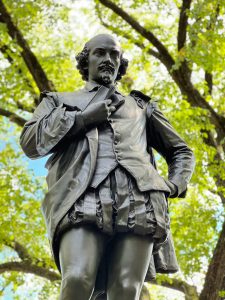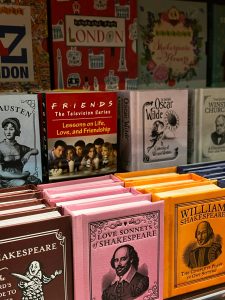Weekend Recs: Shakespeare Adaptations

Happy Friday, Wildcats! Falvey Library is delivering you another semester of Weekend Recs, a blog dedicated to filling you in on what to read, listen to, and watch over the weekend. Annie, a graduate assistant from the Communication department, scours the internet, peruses the news, and digs through book stacks to find new, relevant, and thought-provoking content that will challenge you and prepare you for the upcoming week. A disclaimer that this column is intended for reflection and entertainment (not for academic research, for example), and infuses scholarly content as possible.

Photo by Tim Wildsmith on Unsplash
It’s Shakespeare Week, a week dedicated to celebrating and engaging with the works of playwright and poet William Shakespeare. Of course, Shakespeare’s famed works live on as people continue to read, perform, and analyze them over 400 years after his death, but they have also inspired a plethora of adaptations and retellings that have been modernized for new audiences today to enjoy.
Just recently, Much Ado About Nothing received a retelling in the 2023 rom-com Anyone But You, starring Sydney Sweeney and Glen Powell. Even the now iconic The Lion King is an adaptation of Hamlet. So, in celebrating of Shakespeare Week, here are some modern adaptations and retellings (and some might even surprise you).
If you have 5 minutes…and want to test your Shakespeare knowledge, take this quick quiz, released in celebration of the recent 400-year anniversary of the First Folio, a historic collection of Shakespeare’s works that might have otherwise been lost to history.
If you have 19 minutes…and like Youtube video essays, watch this video discussing how the 1990s and 2000s trend of Shakespeare retellings re-popularized Shakespeare among young people.
Bonus: For a more scholarly take, read this ebook on marketing “The Bard” to Hollywood during the same era.
If you have 37 minutes…and like feminist analyses, watch this video essay on how 10 Things I Hate About You and She’s the Man represent feminism and gender.
Bonus: To see an academic’s take on this subject, read this essay from Borrowers and Lenders: The Journal of Shakespeare and Appropriation.
If you have 1 hour and 37 minutes…and want to feel a little nostalgic, watch 10 Things I Hate About You, available in Falvey’s DVD Collection. This beloved late 90s rom-com starring Julia Stiles and Heath Ledger is actually a retelling of The Taming of the Shrew.
If you have 1 hour and 45 minutes…and like Shakespeare’s comedies, watch She’s the Man, available to stream for free on Pluto. If you’ve read or seen Twelfth Night, you might not be surprised that She’s the Man is an updated (and somehow even more outlandish) retelling.
Bonus: if you want to watch an adaptation more faithful to the source material, watch 1996’s Twelfth Night, available to stream online through Falvey.
If you have 1 hour and 51 minutes…and prefer Shakespeare’s tragedies, watch Hamlet, the 2000s modernized retelling starring Ethan Hawke set in New York City, available to stream online through Falvey.
If you have 2 hours and 41 minutes…and are a fan of David Tennant, watch him and Catherine Tate star in a filmed production of Much Ado About Nothing, available to stream online through Falvey. It might technically be more of a theatrical production rather than an adaptation, but it stars two recognizable film actors, so I’m including it.
Bonus: If you want to check out any more filmed theatrical productions of works by playwrights like Shakespeare and beyond, browse our Digital Theatre+ subscription library.
If you have 6 hours…and like Shakespeare’s dramedy The Tempest, read Hag-Seed by Margaret Atwood. Yes, the Margaret Atwood wrote a Shakespeare adaptation in 2016. Not a traditional retelling, Atwood weaves the Shakespeare’s original work into the plot, following actor Felix as he seeks revenge for having his theatrical dreams crushed.
 Annie Stockmal is a second-year graduate student in the Communication Department and Graduate Assistant in Falvey Library.
Annie Stockmal is a second-year graduate student in the Communication Department and Graduate Assistant in Falvey Library.



 Kallie Stahl ’17 MA is Communication and Marketing Specialist at Falvey Library. Some of her favorite Barbie dolls of the 90’s: Bead Blast Barbie Doll, Olympic Gymnast Barbie Doll, Movin’ Groovin’ Barbie Doll, and Dorothy Barbie Doll (The Wizard of Oz).
Kallie Stahl ’17 MA is Communication and Marketing Specialist at Falvey Library. Some of her favorite Barbie dolls of the 90’s: Bead Blast Barbie Doll, Olympic Gymnast Barbie Doll, Movin’ Groovin’ Barbie Doll, and Dorothy Barbie Doll (The Wizard of Oz). 

